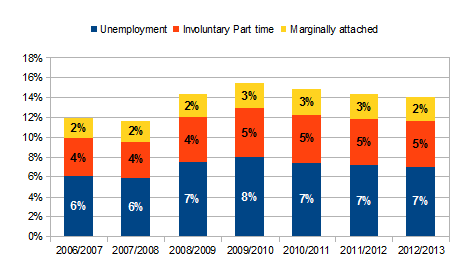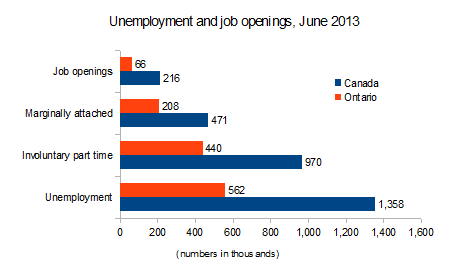Unemployment is higher than you think.
Every month, Statistics Canada comes out with the unemployment rate, and every month it gets a lot of attention. But the unemployment rate provides quite limited information about the actual health of the labour market.
The addition of two other pieces of information nearly doubles the unemployment rate: the proportion of the labour market employed part-time but looking for more work, and the proportion that would like a job but aren’t actively looking for work, and so aren’t officially counted as being in the labour market.
The chart above shows the national annual average for July – August (just to get the most recent data in there). It shows a pretty consistent trend – the broader unemployment rate is pretty close to double the official unemployment rate. And yes, I’ve added the marginally attached to the denominator as well.
When we include involuntary part-time and marginally attached persons, the unemployment to job vacancy ratio sky rockets. For Canada the most recent official number is 6.3, but the broader definition of unemployment yields a number of 13 people who would like a job for every job opening.
For Ontario, the jump is more dramatic. The most recent official number for Ontario is 8.6, but the *real* ratio is 18.4. Ontario has about 43% of expanded unemployment, but only 30% of the job vacancies.
It’s worth noting that the job vacancies counted by Statistics Canada are the number of jobs that were open at the end of the month. We don’t know how long these jobs have been open, because Statistics Canada doesn’t ask. But in a healthy job market, there are always going to be some jobs open. 216,000 job openings represents only 1.5% of employees.
To get an even broader picture of the edges of the labour market, I looked at own-account unemployment as well, meaning self-employed workers who have no employees. Unincorporated self-employed workers who have no employees make up about 7% of the Canadian labour market. Add in those self-employed workers who have decided to incorporate but have no employees, and we’re at 10% of the Canadian labour market. That’s nearly 1.9 million workers who are in a pretty precarious employment situation, to say the least.
Over 2 million Canadians are employed in temporary employment as well, giving us an additional 10% of the labour market that is precariously employed.
That paints a pretty stark picture of our current labour market situation. 14% of the Canadian labour market is unemployed, 10% are self-employed with no employees, and 10% are employed in temporary work. (These percentages are all based on total labour market + marginally attached = about 19.5 million.)
September 17th was the two-year anniversary of the first occupy wall street gathering. The issues that were raised by OWS are still crying out for a serious policy response.



A cautionary tale from economist Bill Mitchell:
The Labor government under Rudd-Gillard failed the most basic test
http://bilbo.economicoutlook.net/blog/?p=25392
It allowed itself to indulge in an obsession about budget surpluses knowing it was driving labour underutilisation (both unemployment and underemployment) up and knowing that joblessness causes misery for the individuals and their families that have to endure the plight.
It did so because it thought that would be rewarded by an ignorant electorate that would see it as good economic managers.
But unemployment is never really accepted as being a good outcome and in many electorates (particularly in the old Labor heartland of Tasmania) the voters sent the signal to the government – failure and out!
______________________________________________
The Labor government under Rudd-Gillard failed the most basic test | Bill Mitchell – billy blog
On September 7, 2013, the federal election in Australia saw the incumbent Labor Party deposed in fairly categorical terms and replaced by the “born-to-rule†conservative coalition (Liberal and Nationals). The Labor Party had been in power for two terms since 2007 after defeating the conservatives ev…
Hi Angella. Sorry again for the ‘piling on’ on Twitter. I do try to avoid that normally…
I prefer to use the term ‘broader measure’ than ‘real’ or ‘true’, since those terms resonate too much for me with internet flotsam about ‘hidden true inflation’ or “Obama’s hidden unemployment numbers” that pervade the nuttiest of right-wing websites.
The sluggishness of labour market recovery from recessions is a new thing over the last few recessions. My colleague Henry Siu has taken a look at this from a macro perspective for the US here: http://www.voxeu.org/article/jobless-recoveries-and-disappearance-routine-occupations, noting that the loss of ‘routine’ jobs really stacks up during the 91/01/08 recessions, and isn’t a smooth trend.
Best wishes.
Unemployment shouldn’t be treated lightly because it could have an impact on many things, including our culture. And in order to prevent it from being serious, action should be performed as soon as possible. Thank you very much for the clear and concise explanation.